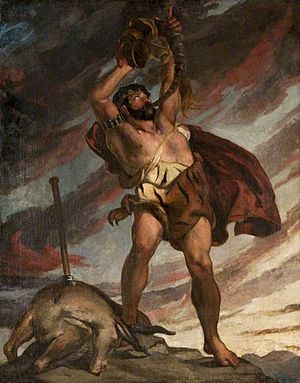Nimrod facts for kids

Nimrod (Hebrew: נִמְרוֹד) is a famous figure mentioned in the Bible. He was the son of Cush and the grandson of Ham. The Bible describes him as a "mighty hunter before the Lord."
Nimrod was known for building many important cities. These included Akkad, Erech (which is also known as Uruk), and Babel. According to ancient stories and the Jewish historian Flavius Josephus, Nimrod became a very powerful ruler. Some legends say he was a tyrant who made his people work on the famous Tower of Babel.
Contents
Who Was Nimrod?
Nimrod is a key figure in ancient history and legends. He is often seen as a symbol of power and leadership. His story appears in different religious texts and traditions.
Nimrod in the Bible
In the Book of Genesis, Nimrod is described as a strong leader. He was a skilled hunter, which was important in ancient times. Hunting provided food and protection for communities. His strength and leadership helped him build cities.
Nimrod in Legends
Many legends tell more about Nimrod. One popular story says he was the king who ordered the building of the Tower of Babel. This tower was meant to reach the heavens. According to these tales, Nimrod wanted to challenge God's power. This led to God confusing the languages of the people. This is why people speak different languages today.
Some legends also connect Nimrod with the biblical figure Abraham. In these stories, Nimrod is sometimes shown as an enemy of Abraham. These tales are part of ancient folklore and religious teachings.
Nimrod's Legacy
Nimrod's story has been passed down through many generations. He is remembered as a powerful king and a great builder. His name is still used in different cultures today.
Cultural Impact
Nimrod's story has inspired many artists and writers. He appears in paintings, books, and other forms of art. These works often show him as a strong, sometimes controversial, figure. His legend reminds us of ancient times and the stories that shaped early civilizations.
Images for kids
-
Pieter Bruegel's The Tower of Babel depicts a traditional Nimrod inspecting stonemasons.
-
Abraham sacrificing his son, Ishmael. Abraham cast into fire by Nimrod. From Zubdat-al Tawarikh, a 1583 Ottoman Turkish manuscript.
See also
 In Spanish: Nemrod para niños
In Spanish: Nemrod para niños




